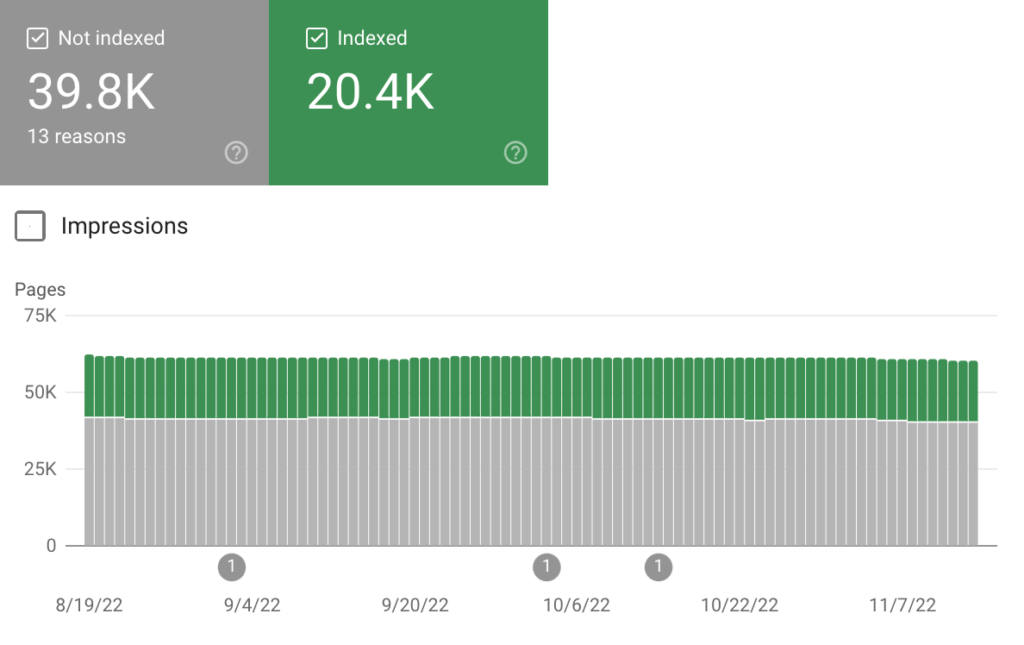While checking the data fidelity of our think tank index project today I stumbled upon a classic SEO problem, a website existing at multiple locations at the same time.
The Carter Center, a think tank that’s roughly four months older than yours truly, showed up on our list as using a non-secure web address. That means its accessible using “http” at the beginning of the web address rather than “https,” the protocol that secures a connection using encryption.
Only about 2% of the groups on our list are still using non-encrypted addresses, so I wanted to make sure this wasn’t a weird error—sometimes we see homepages shows up at the non-secure while the rest of the site is secured. But no, the entire site is visible at both secure and non-secure addresses.
So then I tested www and non-www subdomains. Both of those worked too.
So that means that pages like the Carter Center’s Conflict Resolution Program are available at these addresses:
- http://cartercenter.org/peace/conflict_resolution/index.html
- https://cartercenter.org/peace/conflict_resolution/index.html
- http://www.cartercenter.org/peace/conflict_resolution/index.html
- https://www.cartercenter.org/peace/conflict_resolution/index.html
So for every page, post, event and other URL generated by the Carter Center’s CMS, four URLs are generated, hence we have a four Carters problem.
Why do duplicate pages matter?
Link Dilution
One reason this matters is that any of the four URLs where we see this same content could have links pointing to them. Because links are still an incredible ranking factor in Google’s algorithm (some goes for Bing, Baidu, Yandex, and others) splitting those links up between four page dilutes their power.
And this isn’t just mere speculation. The Four Carters incoming links and domains distribution looks like this according to data provided by Ahrefs Site Explorer (this are rough figures rounded up):
- HTTP non-WWW: 6,870 backlinks from 629 domains
- HTTPS non-WWW: 40,400 backlinks from 799 domains
- HTTP WWW: 359,000 backlinks from 6700k domains
- HTTPS WWW: 624,000 backlinks from 14000 domains
When consolidated, the resulting site would have nearly 1 million backlinks from 15.4k domains (many of the domains pointing to one Carter also point to another Carter).
Cannibalization
Google and other search engines are also potentially crawling and indexing some or all four of the versions of each page on the Carter Center’s website. This could mean that one Carter is competing against another Carter in Google’s rankings. Best case scenario: Google is picking a canonical version of the page, one which may not be what the Carter Center intended.
Best Practice
With rare exceptions, we want to post content to one URL and concentrate all external and internal links on that one page. By creating doppelgänger Carters, Carter Prime is violating both of these fundamental tenants of SEO.
HTTPS is a Ranking Factor
Google has been using HTTPS as a ranking factor since 2014 and incorporated it into its five Page Experience factors in 2021.
So ,the Carter Center isn’t just splitting its link equity and competing against copies of its own content, it’s potentially hindering its ability to rank well in Google results simply by virtue of making anything available at a non-secure address.

But are duplicate pages really an SEO problem?
One way to know for sure if this is a real problem or merely a violation of best practices without much real-world consequence is check out Google Search Console.

To do this thoroughly in this case, you’d need to verify all four Carter address combinations and check to see if Google is indexing pages from each of the four address combinations.
I’d also verify the property as a domain and see what the Page Experience report says about the HTTP issue across all subdomains and protocols.
A Simple Solution to Duplicate Pages
Ultimately, fix like this are always worth it because they are simple, low-cost, and eliminate this problem complete even if Google is doing a pretty good job at making sense of this quadruplicate content.
Pick One Address, Redirect the Rest
The first step is to choose if The Four Carters should be consolidated at a www or non-www address. Sometimes there are technical reasons to choose one or the other, but the most important thing is to pick one.
Once that decision is made, create redirect rules to point all all www requests to the non-www version of the site, or vice versa. Also redirect all HTTP requests to HTTPS.
Canonicalize
Once redirects are in place done, declare a canonical version using a tag in the <head> of the HTML document like this one:
<link rel=”canonical” href=”https://cartercenter.org/peace/conflict_resolution/index.html” />
That should send the clearest signal possible that the four Carters are now just a single, canonical Carter.
More Updates to Come
The Carter Center was on my list of think tanks to review only because their traffic is up 310% from our 2021 Think Tank Index. So despite the technical SEO issue outlined above, the overall performance of The Carter Center is quite good.
There are many other organizations that have seen dramatic increases or decreases in their traffic and we’ve noticed other anomalies like domain name changes, software migrations (some gone terribly badly), and even mergers of think tanks resulting in tremendous SEO success.
You can look forward to more posts like this as we continue to delve through this data.
